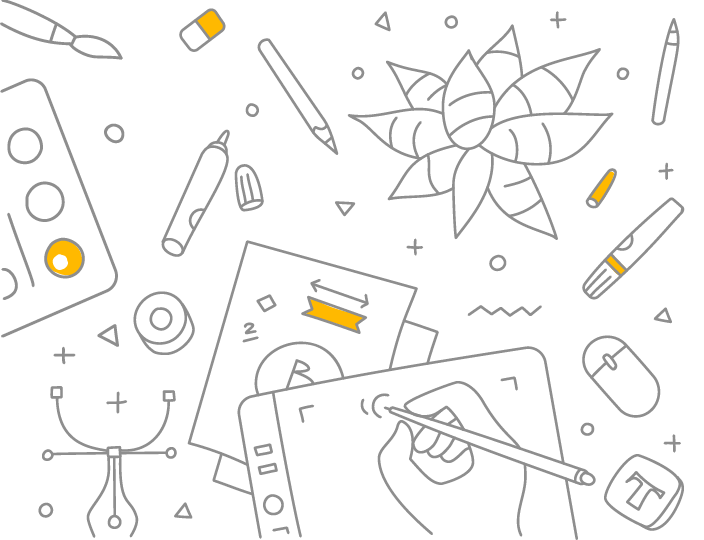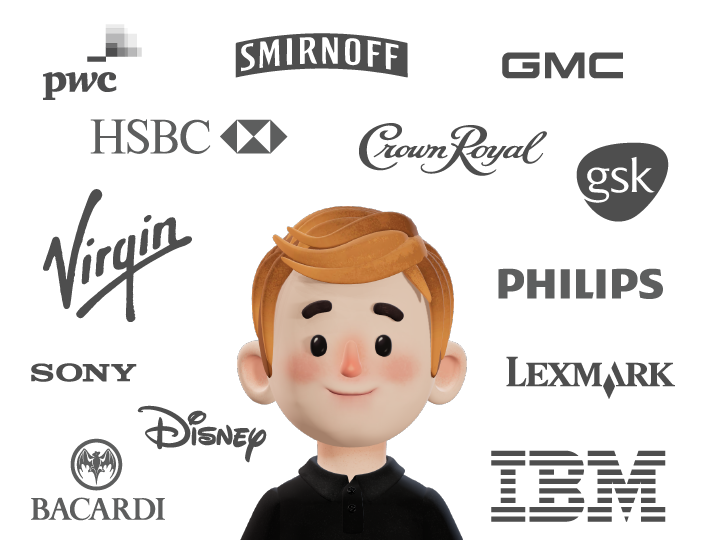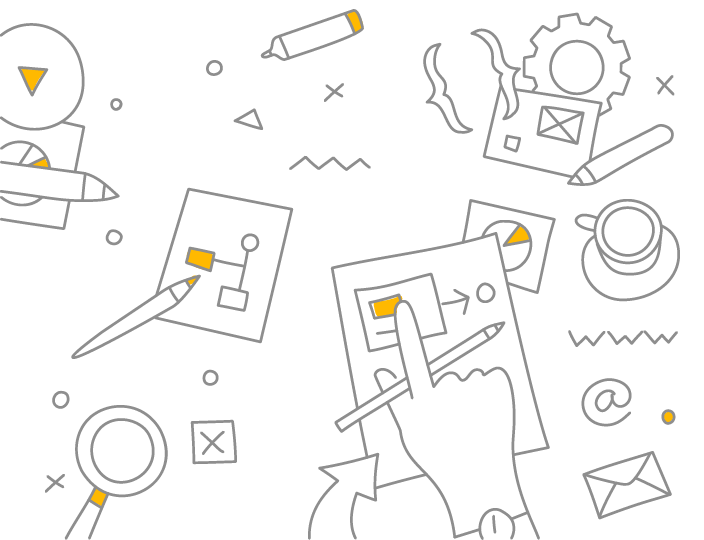GRAPHIC DESIGNER
What is graphic design?
The primary goal of graphic design is to effectively convey information, evoke emotions, or persuade the audience. It involves using design principles and techniques to organize and present visual elements in a way that is visually pleasing, coherent, and functional.
Graphic design is employed in a wide range of mediums, including print materials (such as brochures, posters, magazines, and packaging), digital platforms (websites, mobile apps, social media graphics), advertising campaigns, branding and identity design, signage, and more. It plays a crucial role in shaping the visual identity and communication strategies of businesses, organizations, and individuals.
Graphic designers utilize various tools and software applications, such as Adobe Photoshop, Illustrator, InDesign, and others, to create, manipulate, and refine their designs. They work closely with clients, marketers, or art directors to understand project requirements, target audience, and desired outcomes. They also consider factors like usability, readability, color psychology, and brand guidelines while creating their designs.
Overall, graphic design is a creative and strategic discipline that merges artistic talent, technical proficiency, and a deep understanding of visual communication to produce visually compelling designs.
GRAPHIC DESIGNER
What is a graphic designer?
A graphic designer is a professional who specializes in creating visual concepts, using computer software or by hand, to communicate ideas, inspire, inform, or captivate an audience. They combine art and technology to create visually appealing designs and convey a specific message or evoke a particular emotion.
Graphic designers work in various industries, including advertising, marketing, media, web design, and print publications. They can create a wide range of materials, such as logos, brochures, posters, websites, mobile apps, packaging, and more. The goal is to create visually appealing designs that effectively communicate the desired message to the target audience.
Graphic designers typically have a strong understanding of design principles, color theory, typography, layout, and composition. They use software tools like Adobe Photoshop, Illustrator, and InDesign to create and manipulate images, graphics, and text. Additionally, they may collaborate with clients, art directors, or marketing teams to understand project requirements, develop concepts, and revise designs based on feedback.
A graphic designer is a creative professional who uses artistic and technical skills to create visual designs that communicate messages effectively and leave a lasting impression on viewers.
GRAPHIC DESIGNER
What do graphic designers do?
Graphic designers perform a wide range of tasks and responsibilities depending on their specific roles and the industry they work in. Here are some common activities that graphic designers typically engage in:
Concept Development: Graphic designers collaborate with clients, art directors, or marketing teams to understand project requirements and develop visual concepts that align with the desired message, brand identity, and target audience.
Creating Visual Designs: They use various tools and software applications to create designs, incorporating elements such as images, typography, colors, and layout. This includes designing logos, brochures, posters, websites, mobile apps, packaging, and other visual materials.
Typography and Layout: Graphic designers carefully select and arrange fonts and typography elements to enhance readability, convey a specific tone, and create visually appealing layouts. They consider factors such as hierarchy, spacing, alignment, and overall composition.
Image Editing and Manipulation: They utilize software like Adobe Photoshop to edit and enhance images, retouch photos, adjust colors, and create visual effects or illustrations.
Branding and Identity Design: Graphic designers play a key role in developing and maintaining a consistent visual identity for businesses or organizations. This includes designing logos, defining color palettes, creating brand guidelines, and ensuring that all visual materials align with the brand’s identity and values.
Collaborating with Others: Graphic designers often collaborate with other professionals, such as copywriters, marketers, web developers, or printers, to ensure that the design aligns with the overall project goals and requirements.
Presenting and Revising Designs: Graphic designers present their design concepts to clients or stakeholders and incorporate feedback and revisions into their work. This iterative process ensures that the final design meets the client’s expectations and goals.
Keeping Up with Trends and Technology: Graphic designers stay updated with the latest design trends, software updates, and industry developments. They continually expand their skill set to effectively use new tools and techniques in their design work.
The specific responsibilities of a graphic designer can vary depending on the organization, industry, or freelance projects they are involved in.
GRAPHIC DESIGNER
How much do graphic designers make?
The salary of a graphic designer can vary depending on several factors such as experience, location, industry, skill level, and the size of the company. Additionally, freelancers may have different earning structures compared to full-time employees. It’s important to note that the figures provided below are approximate averages and can vary significantly.
In the United States, the median annual wage for graphic designers was around $54,680 as of May 2020, according to the U.S. Bureau of Labor Statistics (BLS). However, entry-level positions may have lower salaries, while experienced designers or those in senior roles may earn higher salaries.
Here are some general salary ranges for graphic designers based on experience levels in the United States:
Entry-level or Junior Graphic Designer: The salary range for entry-level graphic designers typically falls between $30,000 and $45,000 per year.
Mid-Level Graphic Designer: With a few years of experience, mid-level graphic designers can earn salaries ranging from $45,000 to $65,000 per year.
Senior Graphic Designer or Art Director: Graphic designers in senior roles or with extensive experience can earn salaries ranging from $65,000 to $100,000 or more per year.
It’s important to consider that these figures are not definitive and can vary significantly based on factors such as the cost of living in a specific location, industry demand, and individual negotiation skills.
Furthermore, freelance graphic designers may charge hourly rates or project-based fees. These rates can vary depending on their expertise, reputation, and the scope and complexity of the project. Freelance graphic designers have the potential to earn higher incomes but should also consider factors such as self-employment taxes, marketing expenses, and the variability of work availability.
It is recommended to research salary data specific to your location and consult job listings and industry resources to get a more accurate understanding of graphic designer salaries in your area or the area you are interested in working in.
GRAPHIC DESIGNER
How to become a graphic designer?
Acquire the necessary skills and knowledge: Start by developing a strong foundation in design principles, color theory, typography, composition, and layout. You can pursue formal education through a degree program in graphic design, visual communication, or a related field. Alternatively, you can also learn through online courses, tutorials, workshops, and self-study. Practice using design software like Adobe Photoshop, Illustrator, and InDesign to become proficient in digital design tools.
Build a portfolio: As you learn and develop your skills, create a portfolio of your best design work. Include a variety of projects that showcase your abilities across different mediums and styles. This portfolio will be crucial when applying for jobs or freelance projects as it demonstrates your talent and creativity to potential employers or clients.
Gain practical experience: Look for internships, part-time positions, or freelance opportunities to gain real-world experience in graphic design. Working on actual projects will help you refine your skills, understand client requirements, and collaborate with others in the industry. It also provides an opportunity to expand your portfolio and network with professionals in the field.
Stay updated with industry trends and tools: Graphic design is an ever-evolving field, so it’s important to stay updated with the latest design trends, emerging technologies, and industry practices. Regularly engage in continuing education by attending workshops, conferences, or online courses to enhance your skills and knowledge.
Develop a professional network: Networking is crucial in the graphic design industry. Attend design-related events, join professional organizations, participate in online design communities, and connect with other designers, creative professionals, and potential clients. Networking can lead to job opportunities, collaborations, and mentorship.
Start applying for jobs or freelance projects: Once you have a solid portfolio and some practical experience, start searching for graphic design positions that align with your skills and interests. Create a professional resume and cover letter tailored to each job application, highlighting relevant experience and showcasing your design work. Consider freelancing platforms or online job boards to find initial opportunities.
Continuously learn and grow: Graphic design is a field that requires continuous learning and improvement. Stay curious, explore new design techniques, experiment with different styles, and seek feedback to enhance your skills and creativity. Consider taking advanced courses or pursuing certifications to further specialize in specific areas of graphic design.
Building a successful career as a graphic designer takes time, dedication, and a passion for design. Continuously work on honing your skills, expanding your knowledge, and creating meaningful designs that resonate with your target audience.
GRAPHIC DESIGNER
Where to find graphic design courses?
There are various graphic design courses available to help you enhance your skills and knowledge in the field. Here are some options:
Online Courses and Platforms:
Udemy: Udemy offers a wide range of graphic design courses taught by industry professionals. Some popular courses include “Graphic Design Masterclass: Learn Graphic Design in Projects” and “Adobe Photoshop CC – Essentials Training Course.”
Coursera: Coursera provides online courses from top universities and institutions. You can find graphic design courses such as “Graphic Design Specialization” by the California Institute of the Arts and “Introduction to Graphic Design” by the University of Colorado Boulder.
LinkedIn Learning (formerly Lynda.com): LinkedIn Learning offers a vast library of graphic design courses covering various topics, software, and techniques. Courses like “Graphic Design Foundations: Layout and Composition” and “Logo Design: Techniques” are available.
Skillshare: Skillshare is an online learning platform that hosts a variety of graphic design courses, ranging from fundamentals to specialized topics. Explore courses like “Graphic Design Basics: Core Principles for Visual Design” or “Lettering for Designers: One Drop Cap Letterform at a Time.”
University or College Programs: Many universities and colleges offer degree programs or certificates in graphic design, visual communication, or related fields. These programs provide a comprehensive education in design principles, typography, layout, software skills, and more. Research local institutions to find graphic design programs that fit your needs.
Design Schools or Institutes: There are specialized design schools or institutes that offer focused graphic design courses. These institutions often have intensive programs designed to provide hands-on training and industry-relevant skills. Examples include the Shillington School, General Assembly, and the Miami Ad School.
Community Colleges and Continuing Education: Community colleges and continuing education centers often offer graphic design courses that cater to beginners or individuals seeking specific skills. These courses are usually more affordable and can be taken on a part-time or evening basis.
Before enrolling in a course, consider the curriculum, instructor credentials, reviews, and the specific skills or knowledge you want to gain. Determine if the course offers hands-on projects, real-world applications, and opportunities for feedback and interaction.
Additionally, YouTube tutorials, design blogs, and design podcasts can provide supplemental learning resources and inspiration.
Practice and real-world experience are vital in graphic design. As you progress, actively work on projects, build your portfolio, and seek feedback from peers and professionals to apply what you learn and develop your skills further.
GRAPHIC DESIGNER
Where to find graphic design jobs?
There are several places where you can find graphic design jobs. Here are some common resources and platforms to explore:
Online Job Boards: Websites like Indeed, LinkedIn, Glassdoor, and Monster feature job listings from various industries, including graphic design. You can search for specific job titles or use keywords like “graphic designer” or “visual designer” to find relevant opportunities. Customize your search filters based on location, experience level, and job type (full-time, part-time, freelance).
Design-Specific Job Boards: There are job boards specifically dedicated to creative and design-related roles. Websites like Behance, Dribbble, Creative Jobs Central, Coroflot, and AIGA Design Jobs feature design-focused job postings from companies across different industries.
Company Websites: Visit the career pages of companies or organizations you are interested in working for. Many companies post job openings directly on their websites. Look for the “Careers,” “Jobs,” or “Join Us” sections and browse through their available positions. This allows you to target specific companies you admire or whose values align with yours.
Freelancing Platforms: If you prefer freelance work, platforms like Upwork, Freelancer, Fiverr, and Toptal can connect you with clients seeking graphic design services. Create a profile showcasing your skills, portfolio, and experience, and actively search and apply for freelance projects that match your expertise.
Networking and Referrals: Tap into your professional network and let colleagues, friends, or mentors know that you are actively seeking graphic design opportunities. They may be aware of job openings or refer you to relevant positions. Attend industry events, workshops, or conferences to connect with other professionals in the design community, as they might have insights into job openings or freelance projects.
Social Media: Follow design-related hashtags and accounts on platforms like LinkedIn, Twitter, and Instagram. Sometimes, companies or individuals post job openings or freelance opportunities directly on their social media profiles. Engaging with design communities on social media can also help you stay informed about industry trends and connect with potential employers.
Tailor your application materials, including your resume and portfolio, to each specific job opportunity. Highlight relevant experience and skills that align with the job requirements. Additionally, consider reaching out to design agencies or studios directly to inquire about any available positions or internship opportunities.
Persistence and proactive networking can be valuable in finding graphic design jobs. Keep refining your skills, expanding your portfolio, and staying updated with industry trends to increase your chances of finding suitable opportunities.
GRAPHIC DESIGNER
Interested in more links
coursera.org // careerexplorer.com // masterclass.com // udemy.com // edx.org // rgd.ca // aiga.org // dandad.org // brainstation.io // fiverr.com // linkedin.com // indeed.com


